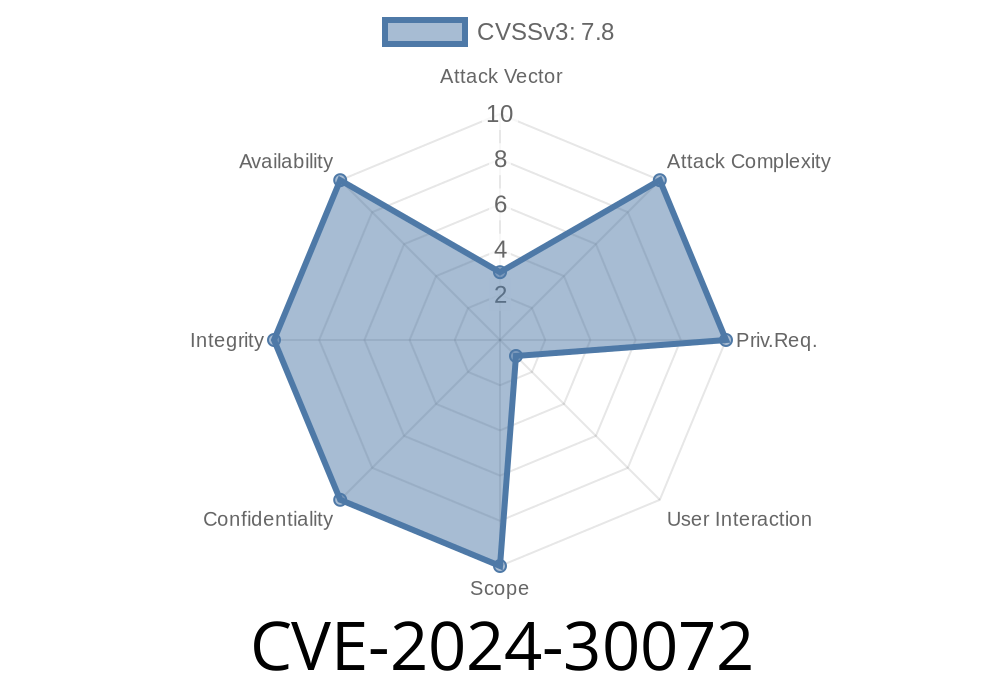Summary: Microsoft's Event Trace Log (ETL) File Parsing has been discovered to have a remote code execution vulnerability, which has been identified with CVE-2024-30072. This vulnerability allows attackers to perform remote code execution by injecting malicious data inside ETL files, which are often generated as logs during software processes. In this extensive post, we will discuss the vulnerability, exploit details, and the preventative measures that should be taken to secure systems from the threat.
Introduction to CVE-2024-30072
CVE-2024-30072 is a critical vulnerability that poses a significant risk to the security of Microsoft Windows systems. The vulnerability stems from the incorrect parsing and handling of Event Trace Log (ETL) files, which are a part of Microsoft’s event tracing framework. The issue allows attackers to execute arbitrary code remotely on affected systems. This vulnerability has received a high CVSS score of 9.8, indicating its severity and potential impact on compromised systems.
The official reference to this vulnerability can be found on the National Vulnerability Database (NVD).
Microsoft Event Trace Log (ETL) File Parsing
Event Trace Log (ETL) files are binary files which are generated by Windows operating systems to record various specific events. These events can include performance information, data exchanged between applications and system components, or system health status. ETL files are generated by various system processes, such as Windows Performance Analyzer or the Windows Assessment and Deployment Kit (ADK).
The vulnerability CVE-2024-30072 is related to an issue in the parsing and handling of ETL files, which can result in the execution of arbitrary code on the impacted system.
Exploit Details
An attacker can exploit this vulnerability by crafting a malicious ETL file that contains a specially formed data structure. This structure is designed to trigger a buffer overflow or a similar type of issue within the ETL file parsing process. As a result, an attacker can hijack the control flow of the host application, potentially leading to the execution of arbitrary code with the privileges of the user running the compromised process.
To better understand and visualize the exploit, let's discuss a proof-of-concept (PoC) code snippet. This example is simplified and serves just for educational purposes, as the real-world exploits may vary and be more sophisticated.
Sample Code Snippet
import struct
import sys
# Crafting the malicious ETL File
def create_malicious_etl_file(filename):
with open(filename, 'wb') as f:
# ETL file header
f.write(struct.pack('I', x12345678))
# Adding malicious payload
payload = b'\x90' * 1024 # NOP sled
payload += b'\xCC' * 256 # Injecting 256 INT3 breakpoints
f.write(payload)
# ETL file footer
f.write(struct.pack('I', x87654321))
if __name__ == '__main__':
output_file = sys.argv[1]
create_malicious_etl_file(output_file)
In this PoC, we create a malicious ETL file by injecting a fake, malicious payload, which overwrites the normal payload buffer. This malicious payload is composed of a series of NOP (no-operation) instructions followed by INT3 (breakpoint) instructions. This is just an example, and in a real-world scenario, the attacker would use a more sophisticated and tailored payload to achieve their goals.
Mitigation and Remediation
Given the severity of the vulnerability, it is essential that organizations take immediate action to secure their systems against potential attacks:
1. Apply the latest Microsoft security updates and patches on all affected systems. Microsoft has released a security update that corrects the way in which ETL files are parsed and handled.
2. Limit the access and privileges of users and processes that handle ETL files to restrict the potential impact of an attack.
3. Use intrusion detection and prevention systems (IDS/IPS) to monitor your network traffic for potential exploitation attempts related to this vulnerability.
4. Implement application-allowlisting solutions and restrict the execution of unknown or suspicious programs, especially those handling ETL files.
5. Train employees and end-users about the risks of downloading, opening, or interacting with unsolicited ETL files or attachments, as opening a malicious ETL file is enough to trigger the vulnerability.
For more information and details on available patches and mitigations, refer to the Microsoft Security Response Center (MSRC) advisory.
Conclusion
CVE-2024-30072 is a critical remote code execution vulnerability in Microsoft's Event Trace Log (ETL) File Parsing system. It is imperative that organizations take timely action to mitigate the risk of exploitation. By applying the recommended security updates from Microsoft and adhering to best practices, organizations can effectively minimize the impact of this vulnerability.
Timeline
Published on: 06/11/2024 17:15:53 UTC
Last modified on: 07/19/2024 21:13:18 UTC
